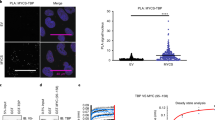Abstract
Heavy metal-induced transcription in mammalian cells is conferred by the metal-responsive 70 kDa transcription factor MTF-1 which contains six zinc fingers and at least three activation domains. In previous cell transfection experiments we have shown that the zinc finger region confers an about 3 fold metal inducibility of transcription, due to its differential zinc binding. However, we also noted that human MTF-1 was more metal-responsive than the mouse factor (about 10 fold versus 3 fold, respectively). Here we analyze this difference in more detail by using chimeric human-mouse factors and narrow the critical region to a 64 amino acid stretch immediately downstream of the zinc fingers, overlapping with the acidic activation domain. A short human segment of this region (aa 313–377) confers efficient metal induction to the mouse MTF-1 when replacing the corresponding mouse region. However, high metal inducibility requires an unaltered MTF-1 and is lost when human MTF-1 is fused to the general activation domain of herpesvirus VP16. Wild type and truncation mutants of MTF-1 fused to VP16 yield chimeras of high transcriptional activity, some exceeding the wildtype regulator, but only limited (about 3 fold) heavy metal inducibility.
Similar content being viewed by others
Literature Cited
Hunziker, P.E., and Kägi, J.H.R. (1985). In Harrison, P. (ed.) McMillian Press, Hounds Mill and London7, pp. 149–181.
Hamer, D. (1986).Annu. Rev. Biochem. 55, 913–915.
Andrews, G.K. (1990).Prog. Fd. Nutr. Sci. 14, 193–258.
Michalska, A.E. and Choo, K.H. (1993).Proc. National Academy Science USA90, 8088–8092.
Masters, B.A., Kelly, E.J., Quaife, C.J., Brinster, R.L. and Palmiter, R.D. (1994).Proc. Natl. Acad. Sci. USA 91, 584–588.
Stuart, G.W., Searle, P.F., Chen, H.Y., Brinster, R.L. and Palmiter, R.D. (1984).Proc. Natl. Sci. USA 77, 122–126.
Carter, A.D., Felber, B.K., Walling, M.J. and Jubier, M.-F. (1984).Proc. Natl. Acad. Sci. USA 81, 7392–7396.
Serfling, E., Lübbe, A., Dorsch-Häsler, K. and Schaffner, W. (1985).EMBO J. 4, 3851–3859.
Westin, W. and Schaffner, W. (1988).EMBO J. 7, 3763–3770.
Radtke, F., Heuchel, R., Georgiev, O., Hergersberg, M., Gariglio, M., Dembic, Z. and Schaffner, W. (1993).EMBO J. 12, 1355–1362.
Brugnera, E., Georgiev, O., Radtke, F., Heuchel, R., Baker, E., Sutherland, G.R. and Schaffner, W. (1994).Nucleic Acids Res 22, 3167–3173.
Heuchel, R., Freddy, R. and Schaffner, W. In: Inducible Gene Expression, Birkhäuser (1995). Boston Basel Berlin,vol I:Environmental Stresses and Nutrients, pp. 206–240.
Radtke, F., Georgiev, O., Müller, H.-P., Brugnera, E. and Schaffner, W. (1995).Nucleic Acids Res. 23, 2277–2286.
Westin, G., Gerster, T., Müller, M.M., Schaffner, G. and Schaffner, W. (1987).Nucleic Acids Res. 15, 6787–6798.
Sturm, R.A. and Herr, W. (1988).Nature 336, 601–604.
Herr, W., Sturm, R.A., Clerc, R.G., Corcoran, L.M., Baltimore, D., Sharp, P.A., Ingraham, H.A., Rosenfeld, M.G., Finney, M., Ruvkun, G. and Horvitz H.R. (1988).Genes Dev. 2, 1513–1516.
Müller, M.M., Ruppert, S., Schaffner, W. and Matthias, P. (1988).Nature 336, 544–551.
Sadowski, I., Ma, J., Triezenberg, S. and Ptashne, M. (1988).Nature,335, 563–565.
Graham, F.L. and van der Eb, A.J. (1973).Virology 52, 456–467.
de Villiers, J. and Schaffner, W. (1983). In: Techniques in the Life Sciences, (B5) Nucleic Acid Biochemistry, Ed. Flavell, R.A. Elsevier Scientific Publishers Ireland, Ltd. pp. 1–20.
Heuchel, R., Radtke, F., Georgiev, O., Stark, G., Aguet, M. and Schaffner, W. (1994).EMBO J. 13, 2870–2875.
Palmiter, R.D. (1994).Proc. Natl. Acad. Sci. USA 91, 1219–1223.
Author information
Authors and Affiliations
Rights and permissions
About this article
Cite this article
Müller, HP., Brugnera, E., Georgiev, O. et al. Analysis of the heavy metal-responsive transcription factor MTF-1 from human and mouse. Somat Cell Mol Genet 21, 289–297 (1995). https://doi.org/10.1007/BF02257464
Received:
Accepted:
Issue Date:
DOI: https://doi.org/10.1007/BF02257464




